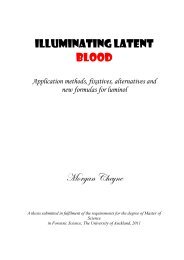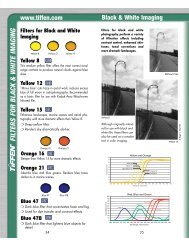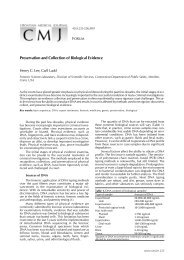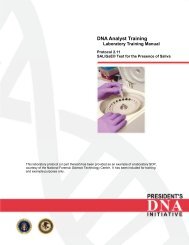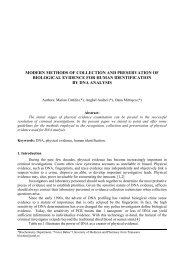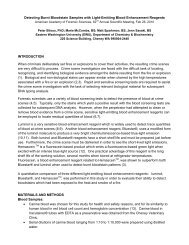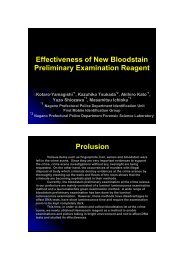Blood-Enhancement Reagents, Luminol, Bluestar®, Fluorescein ...
Blood-Enhancement Reagents, Luminol, Bluestar®, Fluorescein ...
Blood-Enhancement Reagents, Luminol, Bluestar®, Fluorescein ...
Create successful ePaper yourself
Turn your PDF publications into a flip-book with our unique Google optimized e-Paper software.
“<strong>Blood</strong>-<strong>Enhancement</strong> <strong>Reagents</strong>, <strong>Luminol</strong>,Bluestar®, <strong>Fluorescein</strong>, and Hemascein :a quantitative comparison of propertiesessential for crime scene investigations”Peter Bilous, Marion Fossum, Cassandra HallmarkDepartment of Chemistry & BiochemistryEastern Washington UniversityCheney, Washington, USA 99004
Detecting Latent <strong>Blood</strong>stainsCrime Scenes:• Latent (non-visible) bloodstains aredetected using light-emitting bloodenhancement reagentsImportance:• To visualize bloodstain patterns forcrime scene reconstruction• To locate bloodstains for DNA analysiswww.howstuffworks.com
Chemiluminescent <strong>Reagents</strong>• The haem group of hemoglobin acts as acatalyst which accelerates the hydrogenperoxide (H 2 O 2 ) mediated oxidation ofchemiluminescent compounds• This reaction results in light emissionwww.bluestar-forensic.com
<strong>Luminol</strong> and Bluestar®<strong>Luminol</strong>:• Grodsky - 1951• <strong>Luminol</strong>, sodium carbonate, andsodium perborate• Weber - 1966• <strong>Luminol</strong>, sodium hydroxide, andhydrogen peroxideBluestar®:• Blum - 2000• Bluestar® is a luminol-basedcommercial product• Both Bluestar® and H 2 O 2 are providedas tablets for uniformity & conveniencewww.howstuffworks.comwww.bluestar-forensic.com
Fluorescent <strong>Reagents</strong>• The haem group of hemoglobin acts as acatalyst which accelerates the hydrogenperoxide mediated oxidation of fluorescentcompounds• An external light source of 415 - 480 nm isused to excite the oxidized fluorescentcompound, resulting in the emission ofyellow-green lightimages.ookaboo.com
<strong>Fluorescein</strong>:Fluorescent <strong>Reagents</strong>• Cheeseman (1995) –evaluated its potential forcrime scene investigationsHemascein:• Hemascein (2009/10) is afluorescein-based commercialproduct which offersuniformity & conveniencePainted wall + <strong>Fluorescein</strong>Howard & NessanJ For. Ident. 60:682 (2010)www.abacusdiagnostics.com
Materials & Methods• Serial dilutions of canine blood were preparedusing de-ionized(DI) water• Chemiluminescent/fluorescent “workingsolutions” were mixed with diluted bloodsamples and the light emissions quantifiedusing a BioRad fluorometer• Optical Filters for <strong>Luminol</strong> & Bluestar®• 460 ± 5 nm emission filter• Optical Filters for <strong>Fluorescein</strong> & Hemascein• 460 ± 5 nm excitation filter• 520 ± 5 nm emission filterBioRad VersaFluor
Figure 1 Chemiluminescent <strong>Reagents</strong>:Light Emission Characteristics40001:10 000 <strong>Blood</strong> dilution3000RFU20001000BluestarWSP-<strong>Luminol</strong>00 60 120 180 240 300Time (Seconds)Visual limit of detection ~100 RFU
Table 1 Chemiluminescent <strong>Reagents</strong>:Limits of Detection/Sensitivity<strong>Blood</strong> Dilution Bluestar* WSP-<strong>Luminol</strong>*1:1 000 10 370 16 8601:10 000 3 700 3 0901:50 000 770 4201:100 000 230 290* Maximum light emission values (RFU)Visual limit of detection ~ 100 RFU
Figure 2 Chemiluminescent <strong>Reagents</strong>:Stability250001:1 000 <strong>Blood</strong> Dilution20000RFU15000100005000WSP-<strong>Luminol</strong>Bluestar00 30 60 90 120 150 180Time (Seconds)• Tests performed 49 days after preparation of reagent• <strong>Reagents</strong> stored in the dark at 4ºC
Figure 3 Fluorescent <strong>Reagents</strong>:Light Emission200001:800 000 <strong>Blood</strong> Dilution1600012000RFU80004000Hemascein<strong>Fluorescein</strong>00 60 120 180 240 300Time (Seconds)Visual limit of detection ~ 150 RFU
Table 2 Fluorescent <strong>Reagents</strong>:Limits of Detection/Sensitivity<strong>Blood</strong> Dilution <strong>Fluorescein</strong>* Hemascein*1:80 000 16 000 20 0001:800 000 2 110 8 0501:8 000 000 540 6101:80 000 000 ND 180• Light emission values (RFU) at 30 sec• ND = Not detected• Visual limit of detection ~ 150 RFU
Figure 4 Hemascein:Effect of Reagent Concentration1:320 000 <strong>Blood</strong> DilutionRFU150001200090006000300090 %75 %00 60 120 180 240 300Time (Seconds)• Hemascein working solution as per kit instructions = 100%• Dilutions of Hemascein prepared with DI water• <strong>Blood</strong> and H 2 O 2 concentrations were constant• Decrease in light intensity with dilution of Hemascein• Importance of proper working solution preparation
Figure 5 Hemascein:Effect of H 2 O 2 Concentration20000160001:320 000 <strong>Blood</strong> DilutionARFU120008000B400000 60 120 180 240 300Time (Seconds)A = 0.1% v/v H 2 O 2B = 0.3% v/v H 2 O 2
Figure 6 Fluorescent <strong>Reagents</strong>:Stability of Working Solution100001:1 000 000 <strong>Blood</strong> Dilution8000RFU600040002000Hemascein<strong>Fluorescein</strong>00 30 60 90 120 150 180Time (Seconds)• Tests performed 51 days after preparation of reagents• <strong>Reagents</strong> stored in the dark at 4ºC
Summary: WSP-<strong>Luminol</strong> & Bluestar®• WSP-<strong>Luminol</strong> and Bluestar® have comparable lightemission characteristics• WSP-<strong>Luminol</strong> and Bluestar® have similar limits ofblood detection, less than 1 in a 100 000• Only WSP-<strong>Luminol</strong> retained activity after 49 days ofstorage at 4ºC• Our data indicates that the WSP-<strong>Luminol</strong> formulation isa possible alternative to other <strong>Luminol</strong> formulations• A study is in progress to determine the impact, if any,of the WSP-<strong>Luminol</strong> formulation on DNA integrity
Summary:<strong>Fluorescein</strong> & Hemascein• Hemascein exhibited stronger lightemission signals than that of<strong>Fluorescein</strong>, and had a lowest limit ofblood detection , ~1:80 million• Maximum light emissions achieved withHemascein working solution at therecommended strength• Maximum light emissions achievedusing lower H 2 O 2 concentration
Summary:<strong>Fluorescein</strong> & Hemascein continued• Only Hemascein retained activity after51 days of storage at 4ºC• Hemascein’s low limit of detection,long shelf-life, and ease of preparationmake it an excellent option for thedetection of trace quantities of blood• A study is in progress to apply thefindings of this study to the detection oflatent bloodstains
Acknowledgements EWU Department of Chemistry & Biochemistry,Forensic Science Students: Marion Fossum Cassandra Hallmark Kelsey Shears Dr. W. Holleman Abacus Diagnostics
Questions ?Peter Bilous, PhDDirector, Forensic Science ProgramDepartment of Chemistry & BiochemistryEastern Washington UniversityCheney, Washington, USA 99004pbilous@ewu.edu




